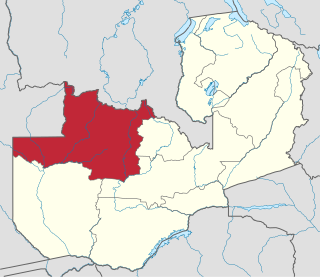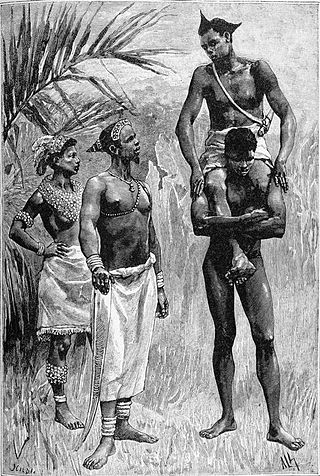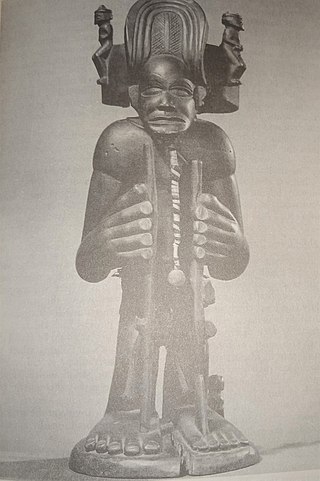Related Research Articles

Zambia, officially the Republic of Zambia, is a landlocked country at the crossroads of Central, Southern and East Africa. It is typically referred to being in South-Central Africa or Southern Africa. It is bordered to the north by the Democratic Republic of the Congo, Tanzania to the north-east, Malawi to the east, Mozambique to the southeast, Zimbabwe and Botswana to the south, Namibia to the southwest, and Angola to the west. The capital city of Zambia is Lusaka, located in the south-central part of Zambia. The population is concentrated mainly around Lusaka in the south and the Copperbelt Province to the north, the core economic hubs of the country.

Moïse Kapenda Tshombe was a Congolese businessman and politician. He served as the president of the secessionist State of Katanga from 1960 to 1963 and as prime minister of the Democratic Republic of the Congo from 1964 to 1965.

Central Africa is a subregion of the African continent comprising various countries according to different definitions. Middle Africa is an analogous term used by the United Nations in its geoscheme for Africa and consists of the following countries: Angola, Cameroon, Central African Republic, Chad, Democratic Republic of the Congo, Republic of the Congo, Equatorial Guinea, Gabon, and São Tomé and Príncipe. The United Nations Office for Central Africa also includes Burundi and Rwanda in the region, which are considered part of East Africa in the geoscheme. These eleven countries are members of the Economic Community of Central African States (ECCAS). Six of those countries are also members of the Economic and Monetary Community of Central Africa (CEMAC) and share a common currency, the Central African CFA franc.
The pre-colonial history of the modern-day Democratic Republic of the Congo encompasses the history of the Congo Basin region up to the establishment of European colonial rule in the era of New Imperialism and particularly the creation of the Congo Free State and its expansion into the interior after 1885. As the modern territorial boundaries of the Democratic Republic of the Congo did not exist in this period, it is inseparable from the wider pre-colonial histories of Central Africa, the Great Lakes and Rift Valley as well as the Atlantic World and Swahili coast.
The Nsenga, not to be confused with the Senga, are a Bantu ethnic tribe of Zambia and Mozambique. In Zambia, they are found in two districts of Eastern province namely Nyimba and Petauke. They are also dialects with the Nsenga Luzi of the Luangwa valley in Chief Nyalugwe, Mboloma and Lwembe and the Chikunda of Luangwa Boma (Feira). Their Senior Chief is Kalindawalo M'ndikula, who resides in Merwe 10 kilometers from Petauke Boma. The following are Nsenga Chiefs: Chiefs Mwape, Nyamphande, Nyanje, Mumbi, Sandwe, Nyalugwe, Ndake, Senior Chief Lwembe, Senior Chief Mboloma and Mwanjaw'anthu. They are well known for their culture and artwork which includes bead work and basketry. They also grow groundnuts, maize, millet and sorghum for consumption and cotton (Thonje) as cash crop, and are popular for their Mbewa (Mice), a practice which they are often teased for. The Nsenga language spoken by people of this tribe has been adopted by many groups in Zambia and diluted to Zambia’s widely spoken language Chinyanja or Nyanja.

Chavuma is a town in the North-Western Province of Zambia, lying immediately south of the border with Angola. The town is approximately 1,100 kilometers from Lusaka and 11 kilometers from the Angolan border town of Kalipande. It lies on the Zambezi River. Local attractions include the Chavuma Falls, while a market takes place on the border, permitting people from both nations to trade.

Luapula Province is one of Zambia's ten provinces located in the northern part of the country. Luapula Province is named after the Luapula River and its capital is Mansa. As per the 2022 Zambian census, the Province had a population of 1,519,478, which accounted for 7.72 per cent of the total Zambian population.

North-Western Province is one of ten Provinces of Zambia. It covers an area of 125,826 km2 (48,582 sq mi), has a population of 1,278,357 and a population density of 20 per square kilometre as of 2021. It is the most sparsely populated province in the country. The provincial capital is Solwezi. The literacy rate stood at 63 per cent in 2010 against a national average of 70.2 per cent. The rural population constituted 77.45%, while the urban population was 22.55%. North-Western Province is bordered along Angola in the west, the Democratic Republic of Congo in the north, Copperbelt Province in the east, Central in the south-east, and Western Province in the south-west.

Kazembe is a traditional kingdom in modern-day Zambia, and southeastern Congo. For more than 250 years, Kazembe has been an influential kingdom of the Kiluba-Chibemba, speaking the language of the Eastern Luba-Lunda people of south-central Africa. Its position on trade routes in a well-watered, relatively fertile and well-populated area of forestry, fishery and agricultural resources drew expeditions by traders and explorers who called it variously Kasembe, Cazembe and Casembe.

The Kingdom of Lunda was a confederation of states in what is now the Democratic Republic of Congo, north-eastern Angola, and north-western Zambia. Its central state was in Katanga.
Kazembe is a name used for Mwata Kazembe's town in the Luapula Province of Zambia, especially on maps and in the Zambian postal service. The other name for the town is Mwansabombwe and this is the one used by its or Luba or Chibemba-speaking inhabitants. They may refer in English to "Kazembe's Village" or just "Kazembe", as traditionally a settlement is named after the chief or headman, rather than the location. The Luba-Lunda shared with many tribes the custom of moving to another village or a new site on the death of the chief. Historical references to a village or town may actually be to a different location. For instance when the explorer David Livingstone visited Mwata Kazembe in 1867 and 1868, "Casembe's town", as he wrote it, was further north at the town now called Kanyembo.

The Lunda are a Bantu ethnic group that originated in what is now the Democratic Republic of the Congo along the Kalanyi River and formed the Kingdom of Lunda in the 17th century under their ruler, Mwata Yamvo or Mwaant Yav, with their capital at Musumba. From there they spread widely through Katanga and into Eastern Angola, north-western Zambia and the Luapula valley of Zambia.
Kanyembo is the principal centre of the population on the Mofwe Lagoon, the largest of several lagoons in the Luapula River swamps south of Lake Mweru, in the Luapula Province of Zambia. It takes its name from its traditional ruler, Chief Kanyembo, one of the senior chiefs of the Kazembe-Lunda under Mwata Kazembe. In the past the incumbent Chief has been promoted to Mwata, and Kanyembo was the site of Mwata Kazembe's capital when it was visited by David Livingstone in 1867.
The Luvale people, also spelled Lovale, Balovale, Lubale, as well as Lwena or Luena in Angola, are a Bantu ethnic group found in northwestern Zambia and southeastern Angola. They are closely related to the Lunda and Ndembu to the northeast, but they also share cultural similarities to the Kaonde to the east, and to the Chokwe and Luchazi, important groups of eastern Angola.
Chief Kanongesha is a Senior Chieftainship of the Kanongesha-Lunda people in the North-Western Province of Zambia, based about 40 kilometres (25 mi) west of the district headquarters, Mwinilunga. Kanongesha is one of three Lunda Senior Chieftainships in Zambia. The current Chief serves under the mantle Mulumbi Datuuma II.
The Kanongesha-Lunda are an ethnic group living mainly in the North-Western Province of Zambia under Senior Chief Kanongesha, around the provincial capital Mwinilunga. The Lunda people of North-Western Province consists of Kanongesha Lunda and Ishindi Lunda.
The Bakwa Dishi is a people belonging to the Luba ethnic group living today in the Kasai-Oriental Province in the Democratic Republic of Congo. Miabi, the Dishi Capital, is located 16 miles (26 km) West of Mbuji-Mayi. The territory of the Bakwa Dishi lies on approximately 1,900 square miles (4,900 km2), which is known as the Miabi territory.

Tshibinda Ilunga or Chibinda Yirung was a Luba and founder of the Lunda Kingdom that covered large parts of modern Democratic Republic of the Congo and Angola.
Arthur Lewis Piper was a medical missionary in the Belgian Congo, supported by the Detroit Epworth League. He worked for the Mission Conference of the Methodist Episcopal Church in the most remote mission station near Kapanga in the Belgian Congo. Piper helped the Lunda tribe battle malaria, sleeping sickness, and leprosy, among many other diseases.
The Ishindi-Lunda are an ethnic group living mainly in the North-Western Province of Zambia under Senior Chief Ishindi, around the provincial capital Zambezi. The Lunda people of North-Western Province consists of Kanongesha Lunda and Ishindi Lunda.
References
- 1 2 3 "Lunda Lubanza". Music In Africa. 2016-06-14. Retrieved 2023-01-12.[ unreliable source? ]
- ↑ "Zambia: Mwati Yamv Preaches Peace At Lunda Lubanza Ceremony, 7 October 2016".
- ↑ Lunda Lubanza: A medley of cultures, 7 October 2016